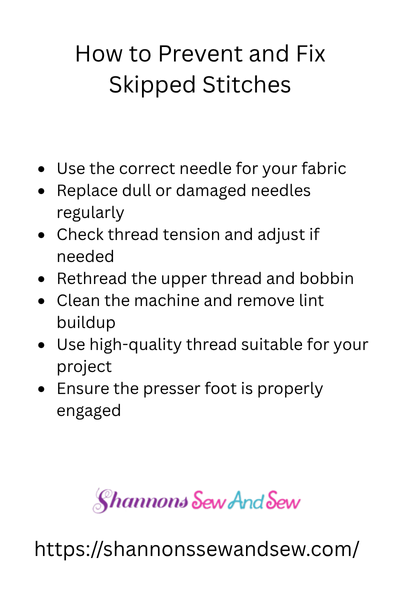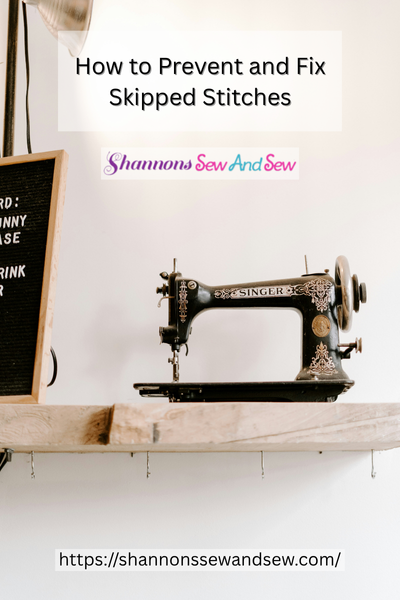Sewing Tips
How to Prevent and Fix Skipped Stitches
If you’re into sewing, you’ve probably faced the frustration of skipped stitches. They’re like that annoying hiccup that throws off your entire project. Don’t worry, though! You’re not alone, and thankfully, there’s a way to prevent and fix skipped stitches. In this post, I’ll walk you through how to tackle the problem once and for all. Let’s get started!
Read More About How to Prevent and Fix Skipped Stitches

The Mystery of Skipped Stitches
So, what exactly are skipped stitches? Well, it’s when your sewing machine’s needle misses a stitch, leaving an unsightly gap in your work. These little hiccups often happen at the worst times, and it’s easy to think your machine is malfunctioning or that you’re doing something wrong. But before you panic, let’s dive into why skipped stitches happen and how to get them under control.
More Things to Know About How to Prevent and Fix Skipped Stitches

What Causes Skipped Stitches?
There’s no single reason your machine might skip stitches, but there are a few common culprits. When I first started sewing, I’d get these skipped stitches, and it drove me crazy. I soon realized that the issue usually comes down to one (or more) of these:
- Needle Issues: A bent or dull needle is one of the most common reasons for skipped stitches. It’s like trying to cut fabric with a dull pair of scissors — it just won’t work smoothly.
- Thread Problems: Sometimes, your thread can be too thick or too thin for the needle you’re using. The wrong combination can lead to stitches being missed.
- Incorrect Tension: If your machine’s tension is off, you might see skipped stitches pop up. The thread won’t move through your machine properly, leaving gaps.
- Fabric Type: Heavy fabrics like denim or leather can be a challenge for your sewing machine. They might cause skipped stitches if you’re not using the right needle or settings.
- Improper Machine Settings: Sometimes, it’s as simple as your stitch length being too short or your foot pressure not being adjusted properly.
How to Prevent Skipped Stitches
You’re probably wondering, “How can I avoid this mess?” Well, I’ve got a few tricks up my sleeve that will keep you sewing like a pro without those annoying skipped stitches.
1. Change Your Needle Regularly
This one’s a game-changer. The needle is responsible for making stitches, so if it’s worn out or bent, your machine won’t function properly. Make sure to use the right needle for the fabric you’re working with (denim needles for heavy fabrics, universal needles for light fabrics). I used to think I could go a long time without changing my needle, but once I started replacing it every few projects, I noticed a big difference.
2. Use the Right Thread
I can’t stress this enough. If your thread is too thick or too thin, it won’t work well with your needle. Always use a thread that’s appropriate for the fabric you’re sewing. For example, use cotton thread for quilting and polyester for general sewing. It’s a small detail, but it can make a huge difference in preventing skipped stitches.
3. Check Your Machine’s Tension
I’ve learned the hard way that tension is crucial for smooth sewing. Too tight, and your stitches will be uneven. Too loose, and your thread might not be pulled through properly. If you notice skipped stitches, play around with the tension settings until you get a balanced result. It took me a while to get the hang of this, but it’s worth experimenting to see what works best for your machine.
4. Adjust the Pressure Foot
I’ve found that adjusting the pressure foot helps my machine move the fabric more evenly. If the foot pressure is too light, the fabric may move too quickly and cause skipped stitches. If it’s too heavy, it can drag the fabric and affect the stitch quality. Try adjusting it based on the thickness of your fabric. It’s all about finding that sweet spot.
5. Use a Walking Foot for Thick Fabrics
If you’re sewing through thick materials like denim or leather, a walking foot can save you a lot of frustration. It helps feed the fabric evenly, preventing skipped stitches and bunching. When I first tried it, I was amazed at how much smoother the sewing process was. Definitely worth having in your sewing kit if you work with heavy fabrics often.
Fixing Skipped Stitches: A Simple Guide
Now, let’s talk about what to do when the dreaded skipped stitch happens mid-project. First off, don’t panic — I’ve been there. Here’s how to get back on track quickly:
- Re-thread Your Machine: It sounds simple, but sometimes the thread gets caught or tangled, causing skipped stitches. Take a moment to unthread and re-thread your machine carefully.
- Replace the Needle: If you’ve been using the same needle for a while, it might be time for a new one. As I mentioned earlier, a bent or dull needle is a major cause of skipped stitches.
- Check the Tension Again: Even if you think your tension is set, it’s always worth double-checking. Adjust it slowly until the stitches are smooth.
- Slow Down: If you’re rushing, your machine might skip stitches due to the speed. Slow down, especially when sewing through thicker fabrics, and you’ll notice a smoother, more even stitch.
Don’t Let Skipped Stitches Get You Down
Skipped stitches are a common problem, but they don’t have to ruin your sewing experience. With a little attention to detail, you’ll be able to prevent and fix skipped stitches like a pro. Whether it’s adjusting your machine’s settings or using the right needle, you’ve got the tools to make it happen.
Master Skipped Stitches Prevention for Flawless Sewing
By now, you should have a solid understanding of how to prevent and fix skipped stitches. Remember, it’s all about making small adjustments and being patient with your machine. Don’t let those pesky skipped stitches keep you from creating beautiful projects — with the right tools and tips, you’ll be sewing smoothly in no time! Keep experimenting, and before long, you’ll be the master of stitch perfection. Happy sewing!




















